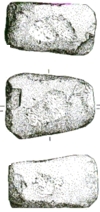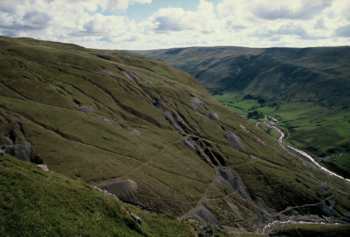

The course of an ancient leat which once fed a small hushing pond located within the prehistoric opencast has been traced over a distance of 500 m from its source, the latter within a small embayment at the head of the Nant yr onnen stream (at 483 m OD). This channel was archaeologically sectioned in 1993 at 3 different locations.
From one of these sections close to the source of the leat a sample of buried peat
within its base was radiocarbon dated to 1190 – 1290 yrs cal AD. This date must relate
to a time after its abandonment. All that we can really say now is that the leat
is at least Early Medieval, but could be earlier (perhaps Roman). The remains of
a late hushing pond and turf stack dam at the front of the in filled opencast were
examined in 1989. The old ground-
![]()
![]()
This website was made possible by a grant from the Cambrian Archaeology Association



Sluice of early post-
Earlier Medieval or Roman leat.
Hushing landscape on Copa Hill on the Comet Lode with ancient leat marked and prehistoric open cut on linear comet Lode (RCAM (Wales) aerial photo.)
Hushing on Copa Hill. (S. Timberlake.)

